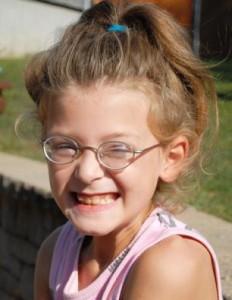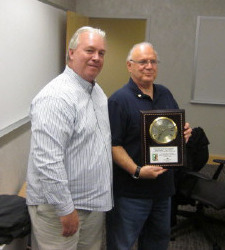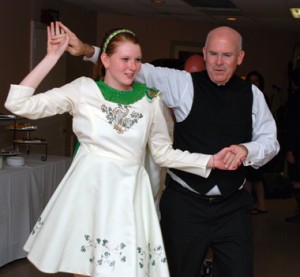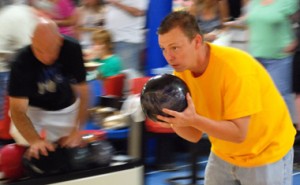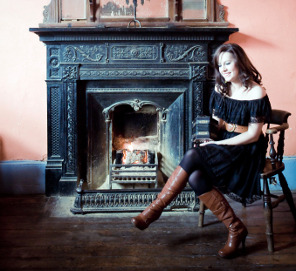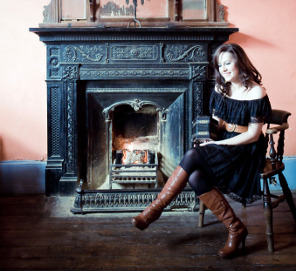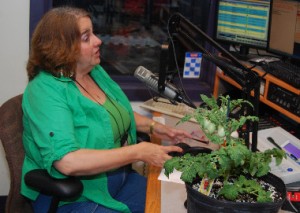
Kathleen Ann Clare O'Connell, doing what she does best ... entertaining and educating kids.
It’s a few minutes before 7 o’clock on a Wednesday night at the University City studios of radio station WXPN. Two floors below street level, tucked away in a boxy basement studio, Kathy O’Connell is seated before a stack of keyboards, blinking buttons and computer monitors. A boom microphone hovers just inches from her face, like an electronic cobra poised to strike.
O’Connell, longtime host of the station’s Peabody Award-winning “Kids Corner,” is having a leisurely chat with frequent guest Jeff Clarke about a tomato plant he has brought in from the Camden Children’s Garden, where he is the supervisor.
From an overhead speaker, we hear the voice of producer Robert Drake, who is tucked away in his own box on the other side of a large window. “Thirty seconds,” he says. O’Connell casually slips a chunky pair of Sony earphones over her graying red hair, and in a moment the familiar strains of the Kids Corner theme fill the room. It’s a catchy little tune, a cross between an electronic synthesizer and the sound of someone blowing across the lip of a Coke bottle.
This is as planned as “Kid’s Corner” gets. O’Connell arrived in the studio only a few steps ahead of Clarke. She wasn’t expecting her guest; Drake ducked in briefly to explain that there was a mix-up in the schedule. Clarke’s unexpected appearance doesn’t throw her off.
O’Connell appears to follow no script, but after the music stops, she smoothly and enthusiastically launches into her intro and then turns in her chair to interview Clarke. The rest of the show hums along with all the reliability of an atomic clock. Kathy O’Connell, every kid’s favorite fun radio aunt, is never at a loss for words.
“The number one rule here is, if something goes wrong, turn Kathy’s mic on right away,” she explains in a post-show interview. “I can talk through anything. This is just some quirky thing I know how to do.”
By all accounts, she does it spectacularly well. She now presides over one of the longest-lived, most acclaimed radio shows exclusively for children, but it is not a career anyone might have foreseen for her.
O’Connell’s early college career, which proceeded in fits and starts—and ultimately a hard stop—had nothing to do with broadcast. She graduated from secretarial school and, for a time, seemed to be following the office worker bee career path.
O’Connell’s long, storied life in radio began by accident—largely in response to a far more notable accident. It was in 1979 that the young O’Connell, riled up over the nuclear disaster at Three Mile Island, started volunteering at the listener-supported, lefty New York radio station WBAI. She answered phones, ran the elevator after midnight and became a member of the small cadre of volunteers—dubbed the “reception riffraff”—who kept the place running.
“As soon as I walked in the door (of WBAI), it was like, ‘Honey, I’m home.’ The only place I had ever felt that comfortable and that at home before that was when I started hanging out at Channel 5 in front of the Soupy Sales show in 1965,” she says. “I recognized that sense of familiarity, and I stayed. I wound up really building a life there.”
Regardless of what anyone else might have predicted, it’s not a complete surprise to O’Connell that her deep fascination with radio was able to take root at WBAI. “I was always the kid entering talent shows and doing dancing school. I did standup comedy for a while. While I went into WBAI without the agenda of ‘Oh, I’m going to get a career in radio,’ performing was part of the deal for me always.”
Kathleen Anne Clare O’Connell made her debut in Mary Immaculate Hospital in Bayside, Queens; she grew up in Huntington, Long Island. Given her name, her obvious Irish Catholic roots and her early childhood in two hotbeds of Irish-American culture, you’d expect O’Connell to have grown up—as the saying goes—as Irish as Paddy’s pig.
Certainly, Irish influences were everywhere in O’Connell’s life. Her father, Thomas John O’Connell, was a New York City cop. So was her grandfather, and her great-grandfather. Her uncle Eddie was with the New York City Fire Department and her Uncle Steve was a New York City cop. Her father was a Hibernian and, for a time, he ran the local St. Patrick’s Day Parade–about which, O’Connell has one standout memory.
“One year he died a puppy’s fur green. I’m not proud of that,” she laughs. “He did it with food coloring. The pictures were in Newsday, which was a black-and-white newspaper, so you have black-and-white pictures of this dog who was dyed a very light shade of green. This was my father’s publicity stunt. I think that was his equivalent of painting a green stripe down the middle of the road.”
She remembers a time when her father brought home a book called “Cry Blood, Cry Erin.”
“He said he wanted us to know where we came from,” she says. But the book sat on the coffee table, unread. In fact, no one other than her father talked much about their Irishness.
She remembers when Father O’Brian, pastor of St. Hugh of Lincoln Catholic School, called upon her during report card time and asked her, “When is St. Patrick’s Day?” “I said… March 19th? He made sure I never forgot it again!” she says.
That no one thought much about “the ould sod” wasn’t all that unusual in those days, she says. “There was a real disconnect between that country over there that we came from and the Irish identity here in America. That was a very strong thing. We’d probably tell you our family was from New York before we’d tell you we were from Ireland.”
So that was Kathy O’Connell’s early life… a plain-vanilla ‘60s American upbringing in a plain-vanilla town that was just a stop along the Long Island Railroad.
And then Soupy Sales happened along.
To most, Soupy was just the popular pie-in-the-face host of what was ostensibly a kids’ show. To a kid growing up in the far New York City suburbs, though, Soupy probably seemed like a major subversive influence.
At the age of 13, O’Connell started taking the train into the city and hanging out at Channel 5, the station where Soupy did his show. She joined a gaggle of girls who dogged Soupy’s every step. in time, she began to have conversations with him, and started to get to know him.
“May 27, 1965, was Ascension Thursday, and I had off from school. I was in 8th grade. That was the first time I went into New York to see the Soupy Sales show,” she recalls. “I became a regular. My friends and I basically stalked him. We would follow him everywhere. I was not as bad as a couple of my friends, who planted themselves outside of his house on 80th Street every weekend.”
For most of O’Connell’s teenage years, stalking Soupy was an all-consuming passion. But as she entered her late teens, she moved on to more adult interests and, in 1968, deeply adult concerns. That was the year, she says, that her family “fell apart.” Kathy O’Connell moved on from the passions of her early adolescence, unaware of the part that Soupy Sales would someday play in her life.
In 1972, O’Connell’s father died, followed in 1976 by her mother. Her mother’s life insurance settlement made it possible for her to explore interests beyond the secretarial pool. That’s when O’Connell started volunteering at WBAI.
Although she started by performing menial chores, she started taking classes offered by the station, learning how to operate the sound board. Then she was asked to read the community calendar—which she did to accompaniment of little comedy routines and wacky sound effects like the “Dragnet” theme. The station management liked her work so much, they offered her regularly scheduled shows.
She then moved to WNYC, the city’s large public radio station—not on air, but again working the board. One night in 1983 when she was pulling engineering duty, the two co-hosts of the station’s show for kids walked off with only minutes to go before air time.
“Four people in suits came walking in, one of whom was the program director, and he says to me, ‘We need you to help us out.’ None of them knew what buttons to push to keep the show on the air,” she says. “I said, ‘You let me talk and I’ll help you out however I can.’ That was when I got the job at ‘Small Things Considered.'”
The three-hour show wound up winning a Peabody Award. It morphed into a nationally syndicated show called “Kids America.” That was a pretty rapid rise, but O’Connell’s career seemed to come to an abrupt halt when the Corporation for Public Broadcasting declined to renew its financial support for the show.
Christmas Eve 1987, marked the show’s swan song. “A Merry Christmas, I don’t think!” she exclaims in her silly Kid’s Corner voice.
A couple of months before “Kids America” bit the dust, Philadelphia radio station WXPN picked up the syndicated show. Not long after the show folded, the station manager called up O’Connell and asked: How would you like to start a kids’ show in Philadelphia? She remembers her grateful response: “I said, I’ll give Philly a year, sure.”
O’Connell came to the city the weekend after Christmas. January 4, 1988, was the first show. Starting a new show in 10 days would be a daunting proposition for anyone, and O’Connell truly felt the pressure. But the show must go on… and it did.
“Here’s where WBAI’s training really, really helped. I said to myself, OK—I’ve got to talk for an hour and a half. I can do that,” she says. She resolved to play kids tunes she had hijacked from WNYC—”I think the statute of limitations has run out on that,” she says—and make up a history game, and then open up the phones.
“Thank God for WBAI and their live radio department,” O’Connell says. “I did worry about what I was going to do on that first show. I mean, there was planning. But I knew that I wasn’t going to know what would happen until the on-air light went on.”
She remembers WBAI talk radio being very confrontational. With kids, there’s no confrontation. “They may say ‘what?’ a couple hundred times, but they don’t come to argue,” she says. “They’re a really great starting off point. It’s not hard.
Amazingly (but probably not to O’Connell, who radiates self-confidence), the show went very well. There was even another Peabody Award. Life was very good indeed. In 2002, it got better.
O’Connell, who had continued to run into Soupy Sales now and again, renewed the relationship. “That’s when I got to know his second wife, Trudy,” she says. “Soupy and Trudy, from 2002 and on until the day he died, when I was with him, they were like my parents. “I got to see Soupy’s look of pride on his face, watching me up on the stage or coming to an event where my fans were, and watching me sign autographs. He was like my dad.”
It’s a sign of Sales’ high regard for O’Connell that, after he died in 2009, she inherited his two memorable puppets, “White Fang” and “Black Tooth.” She’s hoping to donate them to the Smithsonian.
When O’Connell looks back on her career, it’s clear to her now that Soupy Sales was always a profound influence. She knows she has a fairly large adult audience, along with the kids. It’s because her brand of radio works on both levels. She remembers Soupy’s “stuff” working the same way. “He could say something that worked on a goofy kids’ level, and then go on to make Leopold and Loeb jokes,” she says.
“I used to say to Soupy all the time, ‘Thank God I wasted my life on you. I still do his jokes and the things Iearned from him. I learned from the best. I learned from Soupy.”

